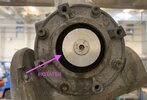Where best to look for help to identify how to build and assemble a simple device to alert me (with a load buzzer and flashing light) that a shaft on a gear motor is no longer turning? I have a piece of food equipment that gets stuck and burns out the 1/2 HP motor. This is my third time getting it rewired. Ideally, looking for a simple solution that doesn't require a board but simple components that can be wired together,
It can be optical, magnetic, or mechanical. I was thinking of gluing a magnet on the rotating flat part on the backside of the gear motor with a reed switch tracking movement.
I seek help identifying the correct part numbers and general guidance on putting it together. The design constraints are each and cheap. I am not a programmer, but I know how to solder.
Thanks for any leads/advice.
It can be optical, magnetic, or mechanical. I was thinking of gluing a magnet on the rotating flat part on the backside of the gear motor with a reed switch tracking movement.
I seek help identifying the correct part numbers and general guidance on putting it together. The design constraints are each and cheap. I am not a programmer, but I know how to solder.
Thanks for any leads/advice.






